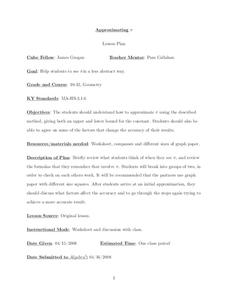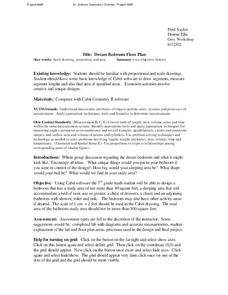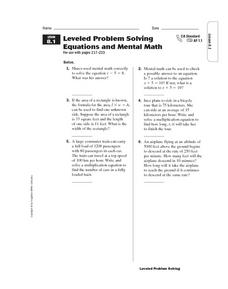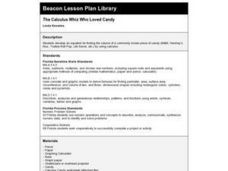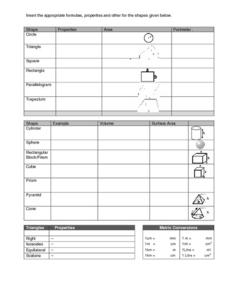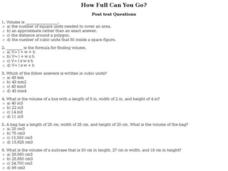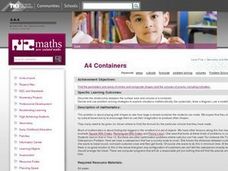Curated OER
Approximating Pi
Students approximate Pi using the lower and upper bound for the constant. In this algebra lesson, students work in groups of two to graph a circle and approximate Pi using the circumference. They repeat their estimation until they come...
Curated OER
Math on the Ragbrai-Using the Proper Tools to Solve Problems
In this problem solving tools activity, students complete a set of 10 multiple choice questions. Worksheet is labeled as a "pre test."
Alabama Learning Exchange
Density
Learners observe a demonstration of regular soda versus diet soda. In this exploring density instructional activity students complete a lab on density and present a PowerPoint presentations of their results.
Curated OER
Dream Bedroom Floor Plan
Students build and apply concepts of geometry. In this geometry lesson, students create a building using proportions and scale drawings. They use Cabri technology to create a virtual drawing first.
Curated OER
Dream Bedroom Floor Plan
Students construct using Cabri software. For this geometry lesson, students convert between units and apply the correct measurements to build objects. They create the room virtually and manipulate the shapes to the desired measurements.
Curated OER
A Look at the Population Density of the United States
Students acquire census information and create maps of the population density of the United States on different scales. They role play the roles of workers of a retail company and they use the population data to market to their customers.
Curated OER
Creating a "Concrete" Spreadsheet
Students create a spreadsheet that calculate the amount of concrete needed to pour various concrete forms.
Curated OER
Leveled Problem Solving Equations and Mental Math
In this equations and mental math practice worksheet, students sharpen their problem solving skills as they solve 6 story problems.
Curated OER
All About Circles
In this all about circles worksheet, students interactively answer 10 multiple choice questions about circles, then click to check their answers.
Curated OER
The Calculus Whiz Who Loved Candy
Students develop an equation for finding the volume of a commonly known piece of candy (M&M, Hershey's Kiss, Tootsie Roll Pop, Life Saver, etc.) by using calculus.
Curated OER
Pi Day (March 14)
Fourth graders determine the value of ? by measuring the circumference and diameter of circular objects such as soup cans, Oreo cookies, etc..
Curated OER
Searching The Word
Fifth graders review EOG math terms and definitions found in their math notebooks, and pick between 15 and 20 words to put in a word search.
Curated OER
Babylonian Mathematics 2
Students research Babylonian mathematics. They calculate simple surd numbers. Students find the fractional form of rational numbers expressed as decimals. They work with numbers in base 60.
Curated OER
Properties of Shapes
In this math worksheet, students look for the properties related to each shape and then fill in the graphic organizer with the categories needed.
Curated OER
Does Shape Affect Drag?
Students study drag and how it affects a parachute in the sky. In this parachutes lesson students build models and compare their drag.
Curated OER
Volume: How Full Can You Go?
In this volume: how full can you go activity, students interactively answer 10 multiple choice questions about volume in both metric and standard measure, then click to check their answers.
Curated OER
Geometry Journal: Classifying Solids
In this geometry worksheet, 10th graders respond to journal prompts related to prisms and classifying solid shapes. The two page worksheet contains nine questions. Answers are included.
Curated OER
Optional Laboratory: Calculating Board Footage in a Tree
Middle schoolers work together to complete an experiment calculating the amount of board footage in a tree. They record their data and answer questions at the end of the lesson. They create their own hypothesis as well.
Curated OER
Using the Pythagorean Theorem
Middle schoolers apply the Pythagorean Theorem to solve real-world problems. They draw diagrams based on written descriptions to calculate the examples.
Curated OER
Searching the Attic
Students investigate an attic or basement to "discover" family artifacts. They develop a grid map using string, create a naming system for the grid, and analyze items of interest.
Curated OER
A4 Containers
Fifth graders determine which container made from a single sheet of paper has the greatest volume. They look the solutions made by three different students before working on their own examples.
Curated OER
Perimeters, Patterns, and Conjectures
Students discover patterns and write conjectures relating to perimeters and polygons. Working in cooperative learning groups, they use manipulatives and graphic organizers to solve problems then answer a series of questions in which they...
Curated OER
Harnessing the Wind for Electricity
Ninth graders explain how wind can produce electricity. For this geometry lesson, 9th graders construct their own pin wheel turbine and calculate its power. They discuss the pros and cons of using wind generator.
Curated OER
Peter's String
Students are introduced to the math problem and consider how they could approach it. In pairs, students investigate Peter's conjecture in any way they see fit. They then share their answers with the class.


